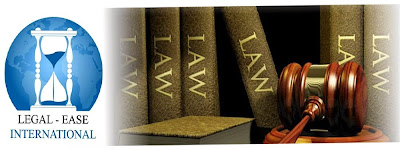TRANSLATION OF LEGAL DOCUMENTS
By Dena Falken
What is a Legal Document?
A legal document is generally a document in which two or more parties enter into an agreement and which is finally confirmed by their signature. The term legal documents have a very broad concept in terms of documents required for disclosure and court.
Often in a particular case, the court will have to decide which types of documents are considered legal documents relevant to the case. When drafting a legal document for the conclusion of a contract, all parties must agree and sign the document. If you do not sign the document, it cannot be considered binding in court.
Many people confirm the "verbal agreement" theory. But you should always remember the old clichés: "The deal is as good as the newspaper is written." Failure to sign the document is not legal. The legal document is legally binding in the eyes of the court.
What Is A Legal Translation?
Legal translation is a field of translation that translates legal documents and materials from one language into another while respecting their original meaning. This type of translation consists of a procedure that takes into account the legal framework. Among the various documents that can be translated in connection with the law are the following:
· Contracts
· Court records and transcripts of witnesses
· Deposits
· Confidentiality agreements
· Wills and trusts
· Requirements
· Politics
· Legal notice
· License
· Litigation documentation
· Referee translation
· Legal restrictions
· Others
‘Legalease’ is almost like its own language. A legally educated person is needed to understand. The same thing happens with legal translators. You should know the laws of the country, as a literal translation may not accurately reflect the meaning of the original. It is important that court translators understand the legal implications of what is being translated.
Translation Of Legal Documents
Translation is a very important aspect of modern legal work. This is more common among lawyers and clients as international cases and documents are more widespread. The world is getting smaller and communication is faster. This allows more and more companies to collaborate and use more documentation in all aspects of human communication. From translating passport documents to the complex job of translating documents in an international legal dispute, legal translations are much more in demand than ever before.
In legal documents, each word has a much greater meaning than in any other context. For example, these documents are often discussed in lawsuits, and because of the severity of such a thing, documentation of the dispute is very important. That could decide the case.
If this document is in a language other than that used by lawyers, it is essential that a highly qualified court translator be available to translate the legal documents. There is no room for error, which is why legal translation is a highly specialized area. We only need to take into account the nature of some recent major international cases in order to understand the importance of a good translation of legal documents.
In principle, it is essential that all participants be clarified on legal issues related to such documents. This means that everyone who has a role in any legal matter has the opportunity to understand it and that language is not an obstacle to that understanding. This means that the best legal translator is involved in translating legal documents so that the case can be resolved quickly and save everyone money and time.
Some of the documents that can be included in legal translations include:
· Translations of contracts, where important contracts, both between individuals and between companies, are accurately translated to all parties. If this is not done correctly, the consequences are obvious.
· Confidentiality agreements. People who trade with each other often take advantage of this or employ freelancers. These are documents of great importance, especially when it comes to confidential information. Therefore, companies primarily want to ensure that their legal documents on this topic are prepared and translated by experts.
· Government documents and information. They can be all kinds of important and legal documents that link politics with governments, national and local. It is particularly important that they are properly translated, as they are part of public service contracts and have a direct impact on the lives of communities, both locally and nationally.
Legal documents are vital and often require the person who uses them to read them very carefully. Legal professionals can be hired to monitor or monitor them, and this process cannot occur if there is a language barrier. For this reason, the translation of legal documents is undoubtedly one of the most important tasks of today's legal industry.
Legal document translation includes document types such as contracts, corporate or government motions, court transcripts, confidential agreements, laws, witness statements, ordinances, wills, birth certificates, bank deposits, immigration documents, and notarial documents.
Useful tips for translating legal documents
Ø Make sure that the original document is clearly structured and organized and that the translated document is completed in the same way.
Ø If necessary, seek the advice of a lawyer at the target group. Contacting experts in the field will be invaluable, especially in the case of witness statements and government documents and conditions.
Ø You must be familiar with the terminology and rules of your country, which are specifically stated in the document.
Ø Before you start translating, you need to know how and where the translation will be used. This affects the way you do your work and gives you a more sophisticated approach to translation.
Ø The translation of legal documents must always be done accurately and must follow a specific style of writing the target language. The slightest mistake can lead to complicated or reverse litigation, which makes it different from any other type of translation work.
For any translation information contact us at info@legalenglish.com
www.legalenglish.com



